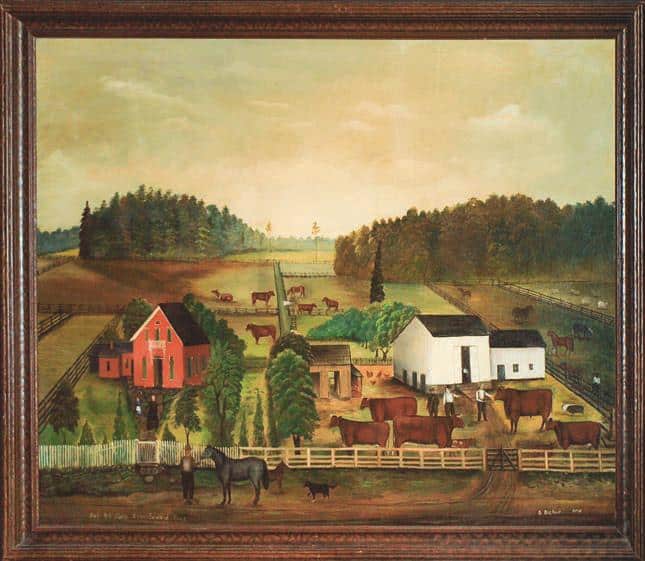 Noblesville Artists: Granville Bishop
Noblesville Artists: Granville Bishop
By: David Heighway, Hamilton County Historian
Hamilton County has had several notable artists in its history, particularly the Brehm brothers and Booth brothers, but few have as interesting a story as Granville Bishop. Bishop was a self-taught painter who, despite being physically handicapped, was able to make a living by painting portraits and landscapes, as well as doing advertising art and teaching penmanship. He supported a wife and five children with his work and to all appearances, he led a good life.
William L. Granville Bishop was born May 31, 1831, in Fayette County, Indiana. His father and mother, Lindsey and Nancy, had emigrated from North Carolina. He was the eldest of what would eventually be five brother and sisters. The family moved to Hamilton County in 1836 and was living in Jackson Township in 1840. The family stayed in Hamilton County until sometime before 1860, when they moved to a home near Unionville in Appanoose County, Iowa. The father was a farmer while living in Indiana and did blacksmithing when he moved to Iowa.
When young, Bishop was afflicted with a rheumatic disorder – possibly rheumatoid arthritis – which cost him the use of his legs. In 1850, while his father is farming, 19-year-old Granville is listed on the census as a shoemaker, an occupation that can be done sitting at a bench. In 1860, his father is a blacksmith and Granville is a schoolteacher. School teaching could be a very physical activity in the mid-nineteenth century, particularly when keeping order among the older children, but with some assistance, it could be done while seated. It would also be an excellent job for someone who could teach penmanship.
Bishop returned to Hamilton County, Indiana by himself in the early 1860s and married Eliza J. Andrews on Mar 23, 1864. She had been born in Switzerland County in 1838 and her family had moved to Hamilton County in 1862. Bishop would spend the rest of his life being an artist in Indiana. He lived in Howard County in 1870, Cicero in 1880, and Noblesville in 1900. His occupation was listed on the various censuses as artist, portrait painter, and “Artist…Pen & Brush”. It’s interesting that at this time he began to use his other name. On documents up to 1864, he would be listed as “William”. After that, although he would have the nickname of “Uncle Billy”, he would be known as Granville for the rest of his life.
One of the best descriptions we have of Granville Bishop is in Wilbur D. Peat’s book Pioneer Painters of Indiana (1954). Peat says about Bishop that, “Incapable of doing any manual labor but finding that he had a natural aptitude for drawing, he turned to art and carried on a rather lively business with his landscapes, portraits in oils and crayon, store signs, and theatrical scenery” [p. 136]. Peat describes one picture as “a characteristic example of his composite scenes (arranged from other pictures and from his imagination)”.
There are four known surviving examples of his work. Two of them – “Thaly Island” (1880) and “Oak Hill Farm” – are in the collection of the Indiana State Museum. Another is image of a farmstead called “Seward’s Farm” which was found in Pennsylvania in 2011.
The last is a portrait of Red Cloud, the Native American leader, which was done for the Redmen’s lodge in Noblesville, possibly for its opening in 1891. It was found in an antique store in south Indianapolis in 2002 and its present whereabouts are unknown. There are perhaps other paintings at Westfield and Sheridan, but these have not turned up in recent years.
Granville and Eliza had five children: Eliza (Metsker), 1867-1902; Flora (Lovell), 1868-?; Arious Courtland, 1870-1942, Lindsey O. “Linn”, 1873-1955; and Albert M.., 1879-?. Arious became a printer and typesetter and worked for the Noblesville Ledger for many years. Linn Bishop began as a painter in a carriage shop and later became a mail carrier in Westfield. He owned several of his father’s paintings in 1954. There is an interesting typographical error in his obituary. It says that his father taught “riding” school near Cicero – which would have been physically impossible. It obviously means “writing school”.
Granville Bishop died November 15, 1902, and was buried in Riverside Cemetery in Noblesville. His obituary said that he was “an artist of more than ordinary ability, but the fact that he was crippled was a handicap to him”. His disability obviously did not defeat his creative spirit. He chose to educate himself in the fine art of painting and to make it his profession. His unique occupation made him well-known in his day and helped to create a legacy for the future.
